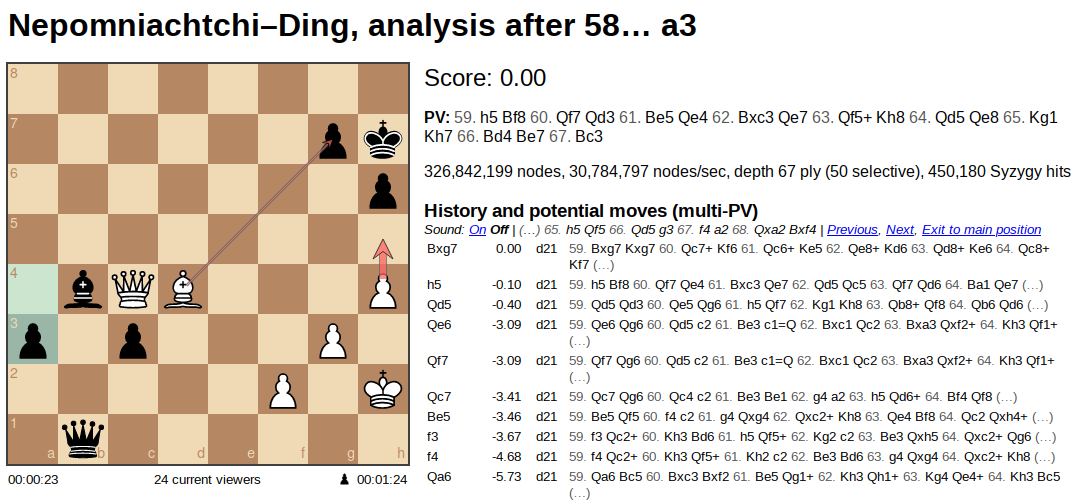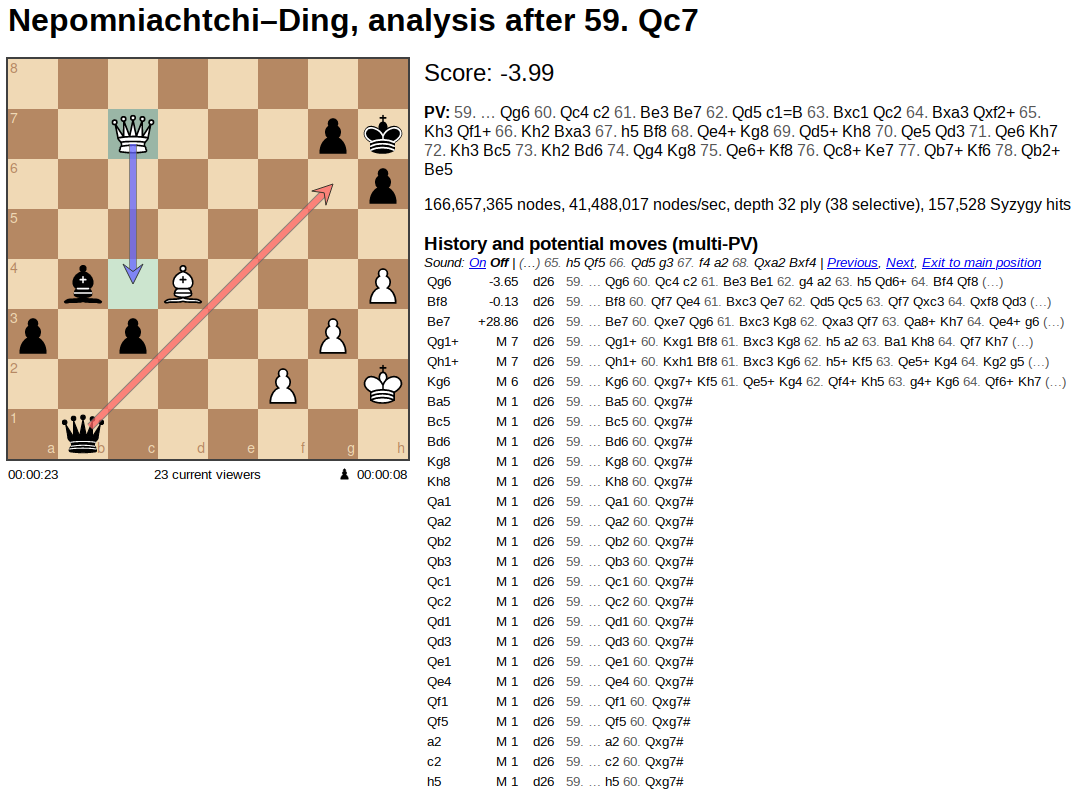Mark Dominus (陶敏修)
mjd@pobox.com

Archive:
| 2025: | JFMAM |
| 2024: | JFMAMJ |
| JASOND | |
| 2023: | JFMAMJ |
| JASOND | |
| 2022: | JFMAMJ |
| JASOND | |
| 2021: | JFMAMJ |
| JASOND | |
| 2020: | JFMAMJ |
| JASOND | |
| 2019: | JFMAMJ |
| JASOND | |
| 2018: | JFMAMJ |
| JASOND | |
| 2017: | JFMAMJ |
| JASOND | |
| 2016: | JFMAMJ |
| JASOND | |
| 2015: | JFMAMJ |
| JASOND | |
| 2014: | JFMAMJ |
| JASOND | |
| 2013: | JFMAMJ |
| JASOND | |
| 2012: | JFMAMJ |
| JASOND | |
| 2011: | JFMAMJ |
| JASOND | |
| 2010: | JFMAMJ |
| JASOND | |
| 2009: | JFMAMJ |
| JASOND | |
| 2008: | JFMAMJ |
| JASOND | |
| 2007: | JFMAMJ |
| JASOND | |
| 2006: | JFMAMJ |
| JASOND | |
| 2005: | OND |
In this section:
Subtopics:
| Mathematics | 245 |
| Programming | 99 |
| Language | 95 |
| Miscellaneous | 75 |
| Book | 50 |
| Tech | 49 |
| Etymology | 35 |
| Haskell | 33 |
| Oops | 30 |
| Unix | 27 |
| Cosmic Call | 25 |
| Math SE | 25 |
| Law | 22 |
| Physics | 21 |
| Perl | 17 |
| Biology | 15 |
| Brain | 15 |
| Calendar | 15 |
| Food | 15 |
Comments disabled
Wed, 31 May 2023
Why does this phrase sound so threatening?
I took it the same way:
The Village of Melrose Park decided that it would be a good idea
is a menacing way to begin, foreboding bad times ahead for the Village.
But what about this phrasing communicates that so unmistakably? I can't put my finger on it. Is it “decided that”? If so, why? What would have been a less threatening way to say the same thing? Does “good idea” contribute to the sense of impending doom? Why or why not?
(The rest of the case is interesting, but to avoid distractions I will post about it separately. The full opinion is here.)
Addendum 20240508
I described Judge Seeger's tone here as “restrained but unmistakably threatening”. Would you like to see what it looks like when he abandons all restraint?
[Other articles in category /lang] permanent link
More about _Cozzi v. Village of Melrose Park_
Earlier today I brought up the case of Cozzi v. Village of Melrose Park and the restrained but unmistakably threatening tone of the opening words of the judge's opinion in that case:
The Village of Melrose Park decided that it would be a good idea
I didn't want to distract from the main question, so I have put the details in this post instead. the case is Cozzi v. Village of Melrose Park N.D.Ill. 21-cv-998, and the judge's full opening paragraph is:
The Village of Melrose Park decided that it would be a good idea to issue 62 tickets to an elderly couple for having lawn chairs in their front yard. The Village issued ticket after ticket, imposing fine after fine, to two eighty-year-old residents, Plaintiffs Vincent and Angeline Cozzi.
The full docket is available on CourtListener. Mr. Cozzi died in February 2022, sometime before the menacing opinion was written, and the two parties are scheduled to meet for settlement talks next Thursday, June 8.
The docket also contains the following interesting entry from the judge:
On December 1, 2021, George Becker, an attorney for third-party deponent Brandon Theodore, wrote a letter asking to reschedule the deposition, which was then-set for December 2. He explained that a "close family member who lives in my household has tested positive for Covid-19." He noted that he "need[ed] to reschedule it" because "you desire this deposition live," which the Court understands to mean in-person testimony. That cancellation made perfect sense. We're in a pandemic, after all. Protecting the health and safety of everyone else is a thoughtful thing to do. One might have guessed that the other attorneys would have appreciated the courtesy. Presumably Plaintiff's counsel wouldn't want to sit in a room with someone possibly exposed to a lethal virus. But here, Plaintiff's counsel filed a brief suggesting that the entire thing was bogus. "Theodore's counsel cancelled the deposition because of he [sic] claimed he was exposed to Covid-19.... Plaintiff's counsel found the last minute cancellation suspect.... " That response landed poorly with the Court. It lacked empathy, and unnecessarily impugned the integrity of a member of the bar. It was especially troubling given that the underlying issue involves a very real, very serious public health threat. And it involved a member of Becker's family. By December 16, 2021, Plaintiff's counsel must file a statement and reveal whether Plaintiff's counsel had any specific reason to doubt the candor of counsel about a family member contracting the virus. If not, then the Court suggests a moment of quiet reflection, and encourages counsel to view the filing as a good opportunity for offering an apology.
[Other articles in category /law] permanent link
Sun, 28 May 2023
The Master of the Pecos River returns
Lately I have been enjoying Adam Unikowsky's Legal Newsletter which is thoughtful, informative, and often very funny.
For example a recent article was titled “Why does doctrine get so complicated?”:
After reading Reed v. Goertz, one gets the feeling that the American legal system has failed. Maybe Reed should get DNA testing and maybe he shouldn’t. But whatever the answer to this question, it should not turn on Article III, the Rooker-Feldman doctrine, sovereign immunity, and the selection of one from among four different possible accrual dates. Some disputes have convoluted facts, so one would expect the legal analysis to be correspondingly complex. But this dispute is simple. Reed says DNA testing would prove his innocence. The D.A. says it wouldn’t. If deciding this dispute requires the U.S. Supreme Court to resolve four difficult antecedent procedural issues, something has gone awry.
Along the way Unikowsky wanted to support that claim that:
law requires the shallowest degree of subject-matter expertise of any intellectual profession
and, comparing the law with fields such as medicine, physics or architecture which require actual expertise, he explained:
After finishing law school, many law students immediately become judicial law clerks, in which they are expected to draft judicial opinions in any area of law, including areas to which they had zero exposure in law school. If a judge asks a law clerk to prepare a judicial opinion in (say) an employment discrimination case, and the student expresses concern that she did not take Employment Law in law school, the judge will assume that the law clerk is making a whimsical joke.
I laughed at that.

Anyway, that was not what I planned to talk about. For his most recent article, Unikowsky went over all the United States Supreme Court cases from the last ten years, scored them on a five-axis scale of interestingness and importance, and published his rankings of the least significant cases of the decade”.
Reading this was a little bit like the time I dropped into Reddit's r/notinteresting forum, which I joined briefly, and then quit when I decided it was not interesting.
I think I might have literally fallen asleep while reading about U.S. Bank v. Lakeridge, despite Unikowsky's description of it as “the weirdest cert grant of the decade”:
There was some speculation at the time that the Court meant to grant certiorari on the substantive issue of “what’s a non-statutory insider?” but made a typographical error in the order granting certiorari, but didn’t realize its error until after the baffled parties submitted their briefs, after which the Court decided, whatever, let’s go with it.
Even when the underlying material was dull, Unikowsky's writing was still funny and engaging. There were some high points. Check out his description of the implications of the decision in Amgen, or the puzzled exchange between Justice Sotomayor and one of the attorneys in National Association of Manufacturers.
But one of the cases on his list got me really excited:
The decade’s least significant original-jurisdiction case, selected from a small but august group of contenders, was Texas v. New Mexico, 141 S. Ct. 509 (2020). In 1988, the Supreme Court resolved a dispute between Texas and New Mexico over equitable apportionment of the Pecos River’s water.
Does this ring a bell? No? I don't know that many Supreme Court cases, but I recognized that one. If you have been paying attention you will remember that I have blogged about it before!
I love when this happens. It is bit like when you have a chance meeting with a stranger while traveling in a foreign country, spend a happy few hours with them, and then part, expecting never to see them again, but then years later you are walking in a different part of the world and there they are going the other way on the same sidewalk.
[Other articles in category /law] permanent link
Fri, 26 May 2023
Hieroglyphic monkeys holding stuff
I recently had occasion to mention this Unicode codepoint
with the undistinguished name EGYPTIAN HIEROGLYPHIC SIGN E058A:
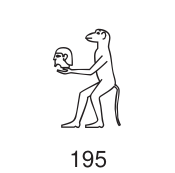
In a slightly more interesting world it would have been called
STANDING MONKEY HOLDING SEVERED HEAD.
Unicode includes a group of eight similar hieroglyphic signs of monkeys holding stuff. Screenshots are from Unicode proposal N1944, Encoding Egyptian Hieroglyphs in Plane 1 of the UCS. The monkeys are on page 27. The names are my own proposals.
SEATED MONKEY HOLDING SEVERED HEAD
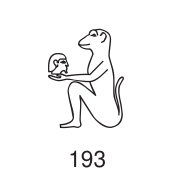
That monkey looks altogether too pleased with itself for my liking.
SEATED MONKEY WEARING DESHRET CROWN AND HOLDING TRIANGLE THINGY

I have no idea what the triangle thingy is supposed to be. A thorn? A bread cone maybe? The object on the monkey's head is the crown of northern Egypt.
STANDING MONKEY HOLDING RIGHT EYE OF RA

What if you want to type the character for a standing monkey holding the left eye of Ra? I suppose you have to compose several codepoints?
STANDING MONKEY HOLDING BALL
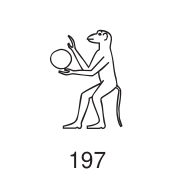
Is it a ball? An orb? A bowl? A dolerite pounder?
STANDING MONKEY HOLDING FLOWER
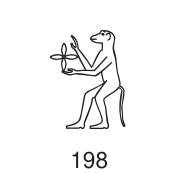
I have no idea what the flower thingy is supposed to represent. Budge's dictionary classifies it with the “trees, plants, flowers, etc.” but assigns it only a phonetic value. (Budge, E. Wallis; An Egyptian Hieroglyphic Dictionary (London 1920), v.1, p. cxxiii)
STANDING MONKEY HOLDING HEDJET CROWN
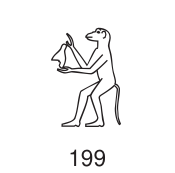
The monkey is holding, but not wearing, the crown of southern Egypt.
STANDING MONKEY WITH LETTER S HOLDING BABY CHICK AND DJED
This last one is amazing.
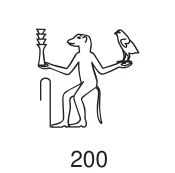
I think the hook by the monkey's foot is a sign with no meaning other than the ‘s’ sound.
The object in the monkey's left hand is quite common in hieroglyphic writing but I do not know what it is. Budge (p.cxxxiii) says it is a “sacred object worshipped in the Delta” and that it is pronounced “tcheṭ” or “ṭeṭ”, but I have not been able to find what it is called at present. Hmmm…
Aha! It is called djed:
It is a pillar-like symbol in Egyptian hieroglyphs representing stability. It is associated with the creator god Ptah and Osiris, the Egyptian god of the afterlife, the underworld, and the dead. It is commonly understood to represent his spine.
Thanks to Wikipedia's list of hieroglyphs.
Addendum: This morning I feel a little foolish because I found tcheṭ in the “list of hieroglyphic characters” section of Budge's dictionary, but when I didn't know what it was, it didn't occur to me to actually look it up in the dictionary.
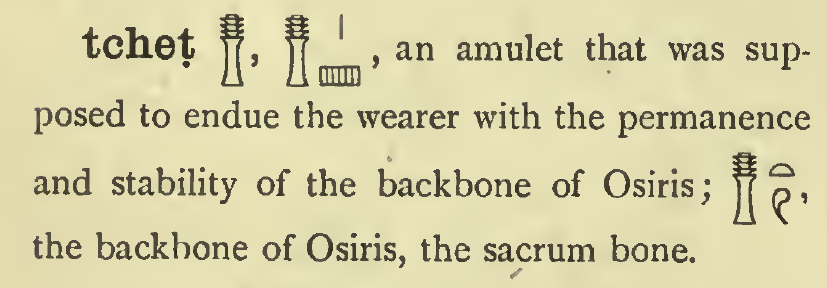
[Other articles in category /lang] permanent link
Thu, 25 May 2023
Egyptian crocodile hieroglyphs in Unicode
A while back Rik Signes brought my attention to the Unicode codepoint
with the long and peculiar name TELUGU FRACTION DIGIT THREE FOR EVEN
POWERS OF FOUR (U+0c7e) and this inspired me to write
an article about what it was for.
Recently I was looking into how Egyptian hieroglyphic characters are encoded in Unicode. The possible character set is quite large; for example here's the name of the god Osiris:

Is this a single codepoint? No, there are codepoints for the three components of the hieroglyph (the kneeling bearded man, the eye, and the polygon thingy that represents a throne), and then some combining characters to say how they should be assembled, also combining characters to indicate notations like cartouches and rubrics.
(I learned this hieroglyphic with the eye part uppermost and the man and throne side-by-side below, but I suppose Egyptian spelling must have changed over the millennia.)
The codepoints themselves have disappointing names like EGYPTIAN
HIEROGLYPHIC SIGN A049, which I think is the designation for the
man-with-beard component. But
the original proposal
hints at something greater. It suggests, and immediately rejects,
a descriptive nomenclature including such names as BABY CHICK,
OWL, HARE,
STANDING MONKEY HOLDING SEVERED HEAD
and
RECUMBENT CROCODILE WITH COBRA HEADDRESS AND FLAGELLUM
But still, what could have been? TELUGU FRACTION DIGIT THREE FOR EVEN
POWERS OF FOUR is only 51 characters long, but RECUMBENT CROCODILE
WITH COBRA HEADDRESS AND FLAGELLUM is 54.
If you want to look it up, it is known as EGYPTIAN
HIEROGLYPHIC SIGN I098, found on pages 36–37 of
the formal proposal.
The suggested glyph looks like this:

Addendum: Rik informs me that he brought the Telugu fraction to my attention not, as I remembered, because it was longest but because it was curious. At the time the longest designation was
ARABIC LIGATURE UIGHUR KIRGHIZ YEH WITH HAMZA ABOVE WITH ALEF MAKSURA ISOLATED FORM
which has since been supplanted by the twins
BOX DRAWINGS LIGHT DIAGONAL UPPER CENTRE TO MIDDLE LEFT AND MIDDLE RIGHT TO LOWER CENTRE
BOX DRAWINGS LIGHT DIAGONAL UPPER CENTRE TO MIDDLE RIGHT AND MIDDLE LEFT TO LOWER CENTRE
I still regret that STANDING MONKEY HOLDING SEVERED HEAD is not the
name of a Unicode codepoint.
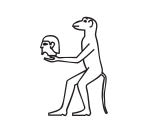
[ Addendum 20230526: More hieroglyphic monkeys holding stuff. ]
[Other articles in category /tech] permanent link
Wed, 17 May 2023
More notes about pain as a game mechanic
In a recent article on rarely-seen game mechanics, I suggested a variation on chess in which a player can force their opponent to retract their last move and play another, by cutting off one of their fingers. This provoked some interesting discussion. First some peripheral matters.
Bloody Knuckles
A couple of people reminded me of the game Bloody Knuckles, a straightforward pain tolerance game in which players take turns pumching one anothers' knuckles until someone gives in.
Slaps
Daniel Wagner also reminded me about the game of Slaps, also called “Red hands”. Wikipedia describes it this way:
One player extends their hands forward, roughly at arm's length, with the palms down. The other player's hands, also roughly at arm's length, are placed, palms up, under the first player's hands. The object of the game is for the second player to slap the back of the first player's hands before the first player can pull them away.
I enjoyed this game when I was younger but as far as I recall we did not play it as a pain tolerance game. For the second player to win it was enough to touch the first player's hands lightly. The first player's hands are held in the air, so there is a firm limit on how much damage the second player would be able to do.
PainStation
Rik Signes mentioned PainStation, a combination arcade game and conceptual art piece that can be found in the Computerspielemuseum (Computer Games Museum) in Berlin.
PainStation is a game of Pong whose interface incorporates a “pain execution unit” for each player that can deliver electric shocks, high heat, or strikes from a small wire whip. A player who removes their hand from the pain execution unit loses immediately.
Hot Dog Cold Dog
Jeb Boniakowski told me about a curious game they played on long winter trips in the car. First there is a “Cold Dog” round: the heat is turned off and the windows opened until one of the travelers gives up. Then there is a “Hot Dog” round: the windows are rolled up and the heat is turned on full blast until someone else gives up. Rounds continue to alternate until the car arrives at its destination, or everyone barfs, I suppose.
Finger-cutting in Chess
I wasn't sure this would be an actually useful option, but Hacker
News user fwlr persuaded
me that it would be. They have kindly given me permission to
republish their HN comment:
A lot of fantastic chess moments are about one player finding the only move that’s good, and high level chess is largely about creating these incredibly tense board positions where there are a lot of possible moves but only a few are safe. For example, Sesse’s analysis of the last [18th] championship game (can’t link to a specific move, use the bar chart or the Previous/Next hyperlinks to go to “analysis after 58… a3”).
This is 50+ moves into a fast paced game and according to supercomputer analysis it is a perfectly tied position. There are two possible moves that keep the game tied or close to tied [Bxg7, h4], and one more possible move [Qd5] that only gives up a very slight advantage (0.5 points is roughly “half a pawn’s value” and is close to the limit of what a human player can confidently detect, this moves gives four tenths of a pawn). Every other move gives up 3 points or more (roughly a full piece, like a bishop) — not always immediately, maybe five or ten moves down the track.
[Nepomniachtchi], playing white, makes one of those “bad” moves (Qc7), theoretically losing the equivalent of almost four whole pawns, a terrible blunder in the eyes of the all-seeing computer. But use the ‘Next’ link to look at the position in “analysis after 59 Qc7”.
There is one move, black Queen to g6, that takes advantage of the “blunder”. There is a second move, black Bishop to f8, that completely cedes the blunder and returns to a mostly-tied position. The third best possible move loses 32 points (going from -4 to +28…). Then there’s two dozen more possible moves, all of which literally lose the game on the spot. [‘M 6’ means that black can force mate in six moves; ‘M 1’ means that black can mate on the next move.]
So to recap: one move gets your opponent ahead, one move keeps him tied, and twenty-four moves lose him the entire game. Being able to cut off your finger to undo and prevent that one good move would change the entire dynamic from “a terrible blunder” to “a bold stroke of pure brilliance”.
In fact Ding did reply with 59…Qg6, the one move that took advantage of the blunder. He won the game, and with it, the world championship. Had Nepomniachtchi cut off a finger at that point, things might have gone differently. (Although his clock had only 23 seconds left, not much time for finger-chopping. Tough to say.)
It's unfortunate that the beautiful analysis page that fwlr links to
is so unsuitable. (For one thing, we can't link directly to the part
of interest; for another, the only way for the user to navigate there
is to click a teeny tiny red bar that is in a cluster of similar bars;
for another, it seems likely that the analysis will not remain at its
current URL. This is why I included screenshots, which are differently
unsatisfctory. If anyone knows of a link target without these
drawbacks, please let me know.
[Other articles in category /games] permanent link
Tue, 09 May 2023My observation that the Moral Majority was neither moral nor a majority had been made many times before. This is not surprising as it was obvious from day one.
Many people suggested other examples, most of which I rejected for the same reason as “Country Crock”: fanciful brand names are not lies, are not (usually) misunderstood, and are not (normally) intended to deceive.
Instead I would like to offer the phrase “egg cream”. This is a beverage made from milk, seltzer water, and chocolate syrup. (Less commonly, some other flavoring.) It contains neither eggs nor cream. And it is deceptive, since people ordering an egg cream are often under the impression that it will contain eggs or cream.
Finally, if you are still sour about the name “Country Crock” margarine and about brand names generally, you might be able to cheer up if you contemplate the proud proclamation of the truth in the brilliantly confident “I can't believe it's not Butter!”
[ Addendum 20230805: Three lies in one. ]
[Other articles in category /misc] permanent link
Sat, 06 May 2023A “pillar box” is a British mailbox. It usually has the monogram (“cypher”) of the reigning monarch at the time it was built. At right are two examples. The one to the right has the monogram of Queen Elizabeth II, also depicted below.
(“EⅡR” is short for “Elizabeth II Regina”). The pillar box to the left has the monogram of her father, George VI.
When Elizabeth was crowned in 1953, there was a dispute in Scotland over what she should be called. “Elizabeth II of Scotland” was a bit of an oddity because Scotland had never before had a queen named Elizabeth: England's Elizabeth I had never been queen of Scotland, which at the time was a separate kingdom. Compare the so-called James VI and I who was King James VI of Scotland but King James I of England. (He was the son of Elizabeth's cousin Mary. James I–V had been the kings of Scotland from 1406–1542.)
Post boxes in Scotland with Elizabeth's “EⅡR” monogram were repeatedly vandalized and in some cases exploded. A lawsuit was filed in Scotland, asserting that the proclamation of Elizabeth II was a violation of the 1707 Act of union between England and Scotland. The court disagreed: “The [Act of Union] did not contain any provision as to the style and titles to be adopted by the monarch of the new [United] kingdom.” The plaintiff was required to pay the respondent's legal expenses.
The two nations found an acceptable compromise: after 1953 pillar boxes erected in Scotland omitted Elizabeth's monogram entirely, and included only a heraldic representation of the crown of Scotland.
The issue doesn't come up with Charles III, who is the third monarch of that name in both England and Scotland.
Pillar box photograph by Kitmaster is in the public domain, via Wikimedia Commons. Elizabeth II's royal cypher by Sodacan is in the public domain, via Wikimedia Commons.
[Other articles in category /history] permanent link
Fri, 05 May 2023
Water, polo, and water polo in Russian
I recently learned January First-of-May's favorite Russian anagrams:
- австралопитек (/avstralopitek/, “Australopithecus”)
- ватерполистка (/vaterpolistka/. ”Female water-polo player”)
Looking into this further, I learned that there appear to be two words in Russian for water polo. Ватерполо (/vaterpolo/) is obviously an English loanword. But Во́дное по́ло (/vódnoye pólo/) is native Russian; вода́ /vodá/ is water.
(Incidentally во́дка /vódka/ is the diminutive of вода́, it's the smaller and more adorable version of water. I feel like this one etymology encapsulates a great deal of the Russian national character.)
I am not sure where Russian got the word по́ло for polo. The English word is borrowed from Tibetan པོ་ལོ /polo/, meaning “ball”. Russian might have gotten it directly from Tibetan, or (more likely) via English. But here's a twist: The Tibetan word is itself a borrowing of the English word “ball”!
[Other articles in category /lang/etym] permanent link
Thu, 04 May 2023
Recent addenda to articles 202304: Inappropriate baseball team names and anagrams in Russian
In 2006 I wrote an article about sports team names, inspired by the amusing inappropriateness of the Utah Jazz. This month, I added:
I can't believe it took me this long to realize it, but the Los Angeles Lakers is just as strange a mismatch as the Utah Jazz. There are no lakes near Los Angeles. That name itself tells you what happened: the team was originally located in Minneapolis
I missed it when it came out, but in 2017 there was a short article in LanguageHat about my article about finding the best anagram in English. The article doesn't say anything new, but the comments are fun. In particular, January First-of-May presents their favorite Russian anagrams:
- австралопитек (/avstralopitek/, “Australopithecus”)
- ватерполистка (/vaterpolistka/. ”Female water-polo player”)
I will have more to say about this in a couple of days.
Eric Roode pointed out that my animation of cubic Taylor approximations to !!\sin x!! moves like the robot from Lost in Space.
[Other articles in category /addenda] permanent link
Wed, 03 May 2023
Notes on rarely-seen game mechanics
A while back I posted some miscellaneous notes on card games played by aliens. Dave Turner has written a response in the same mode, titled “Rarely seen game mechanics”. If you like my blog, you will probably enjoy this article of Dave's.
Dave's article inspired me to write him an email reply, a version of which follows.
[ Content warning: discussion of self-mutilation. ]
Perception
Dave says:
Some time ago, I invented a game where you try to determine physical quantities. Like, you’re given a box full of weights, and you have to determine how many grams it is, just by hefting it.
So far I can only think of one common game that is even a little bit similar to this: guess the number of jelly beans in the jar. As Dave points out, weighing the jar, measuring it, or even picking up the jar are forbidden.
Montessori education focuses on developing a child's perception, and has many activities of this type, not played as competitive games, but as single-person training games. One example is the “sound boxes” or “sound cylinders”. This is a family of twelve opaque containers, usually in six pairs.
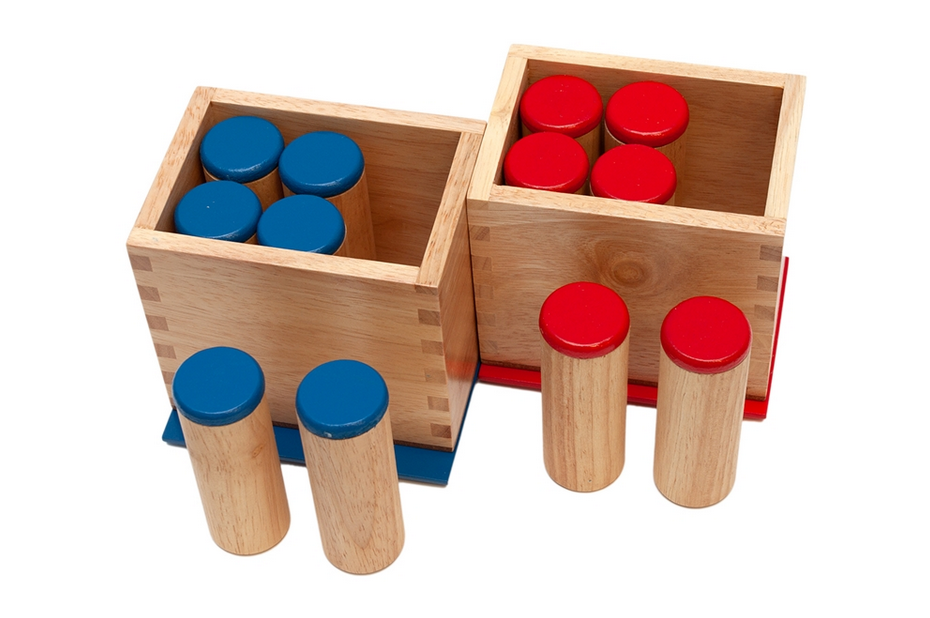
Two containers (call them R1 and B1) contain a small amount of sand, two (R2 and B2) contain dried peas, R3 and B3 contain small pasta, R4 and B4 contain pebbles, and so on. The child is first presented with three cylinders, say R1, R3 and R6. They shake the cylinders close to their ears and listen to the sounds. Then they are invited to listen to R1, R3, and R6 and to match them with their mates B1, B3, and B6. As the child gets better at this, more pairs of cylinders cnn be introduced. Later games involve taking a single set of cylinders R1–R6 and ordering them from quietest to loudest.
Other Montessori equipment of this type includes “baric tablets”, which are same-sized tablets made of different woods, to be distinguished by weight, and “cylinder blocks” which are sets of cylinders in different sizes, to be sorted by size and then put back in their corresponding sockets. None of this is hard stuff for adults, but it is interesting and challenging for a three-year-old. Montessori was a brilliant woman.
My piano teacher would sometimes play two notes and ask me to say whether it was a major third or a perfect fourth or whatever.
Dave mentions a microgame played by Ethiopian girls to choose who gets to go first:
they would instead hide three stones in one hand and four in another, and ask another player to figure out which hand had more stones. Of course, this is also a deception game.
This made me think of Odds and Evens, which was the standard method in New York where I grew up. One player (doesn't matter which) is designated “odds” and the other “evens”. Then on a count of three, the two players each reveal either one or two fingers. If the total number of fingers is even, the evens player wins. I always assumed that this was a game of pure randomness, but now I'm not sure. Maybe other people play it at a higher level, using psychology or trickery to gain an advantage.
Short-term memory
At math camp we used to play a short-term memory game that went like this: The first player would say "I went on a picnic, and I brought an abominable antelope.” Then the second player would say “I went on a picnic and I brought an abominable antelope and a basket of bananas.” Then “I went on a picnic and I brought and abominable antelope, a basket of bananas, and a copy of Charlie and the Chocolate Factory.” If you miss one, you have to drop out. Have-to-drop-out is often a bad game mechanic, but since this is a low-stakes social game, it can be fun to hang around and watch the end even after you're out. And since this was usually played in a larger gathering, it was easy enough to wander away and talk to someone else.
Similarly at one point I worked with an instructor who, on the first day of class, would have the kids do this with their names: kid #7 would have to recite the names of the six kids who had gone before. Unfair to the kids in the back, of course, but that's what you get for sitting in the back. And the instructor would promise ahead of time that he would have go last and the TAs would have to go next-to-last.
Pain tolerance
Dave said:
Dominus suggests a version of chess where you can make your opponent take a move back by chopping off one of your fingers. This is rather permanent (at least for humans). But what about temporary pain?
I had originally imagined this variation played by aliens with many regenerating tentacles, where cutting one off is painful, embarrassing, and inconvenient, but not crippling. But then I thought the idea of playing it as a human was much funnier and more compelling, and it ran away with me.
You enter a chess tournament and sit down. Try to imagine your thought process when you see that your opponent is missing a finger. Or that your opponent is missing three fingers.
There would be stories about how in the 2008 Olympiad Hoekstra was mounting a devastating attack, and thought he was safe because his opponent Berenin was not a finger-chopper. But then Berenin completely foiled the attack by unexpectedly chopping his finger, at just the right moment. (Interviewer: “You have never cut off a finger before. Was it a sudden inspiration, Grandmaster Berenin?” Berenin: “No, I saw what Hoekstra was doing, so I had been planning since move 13 to interfere with his rook defense in this way.”)
Or there might be the legendary game in which Berenin made the devastating move ♘fe6, and when Hoekstra, perhaps panicking, cut off a finger, Berenin merely shrugged and immediately made the equally devastating and nearly identical move ♘de6.
What's the record for one player cutting off fingers in a single game? Is it a legendarily bad game by a reckless dumbass? Or is it a story about how GM Basanian would stop at nothing to win the 1972 world championship? What's the record for two players cutting off fingers in a single game?
Okay, let's try a more plausible variation. Chess, but if your opponent makes a move you don't like, you can force them to take it back and play another by taking a shot of schnapps. Intriguing!
Dave continues, discussing a P.K. Dick story in which the characters take turns holding their fingers in a cigarette lighter. In the story, they're not burned, because Dick, but you could imagine playing this as a brutal game in our non-Dick universe. In fact I thought I might have heard of people playing exactly this game, but I'm not sure.
For a game of this type that I'm certain of, consider Episode 13 of Survivor: Borneo:
Final immunity challenge: Each tribe member held on to the immunity idol while standing on a small log. The person who lasted the longest would win immunity. After two hours of holding on the idol, Jeff tempted the three with oranges. After 2½ hours, Richard gave a speech, said he wouldn't be able to outlast Kelly, and stepped down voluntarily. … After three hours, the two left switched positions while keeping their hand on the idol and were to do so every half-hour. … After 4 hours, 11 minutes, Rudy [inadvertently] took his hand off the idol while switching spots, and Kelly won immunity yet again.
People compete in eating contests, which also has an element of seeing whose body can take the most abuse. And there's that game where two players take turns hitting each other in the face until one gives up or is too battered to continue — I don't know what it's called.
There are also games like Chicken and Russian Roulette (and possibly follow-the-leader) that are about who is willing to tolerate the greatest amount of unnecessary risk.
Conclusion
If you haven't read Dave's article yet, at least check out the thing about the Sichuan peppercorns.
[ Addendum 20230517: More notes about games with pain mechanics. ]
[Other articles in category /notes] permanent link




